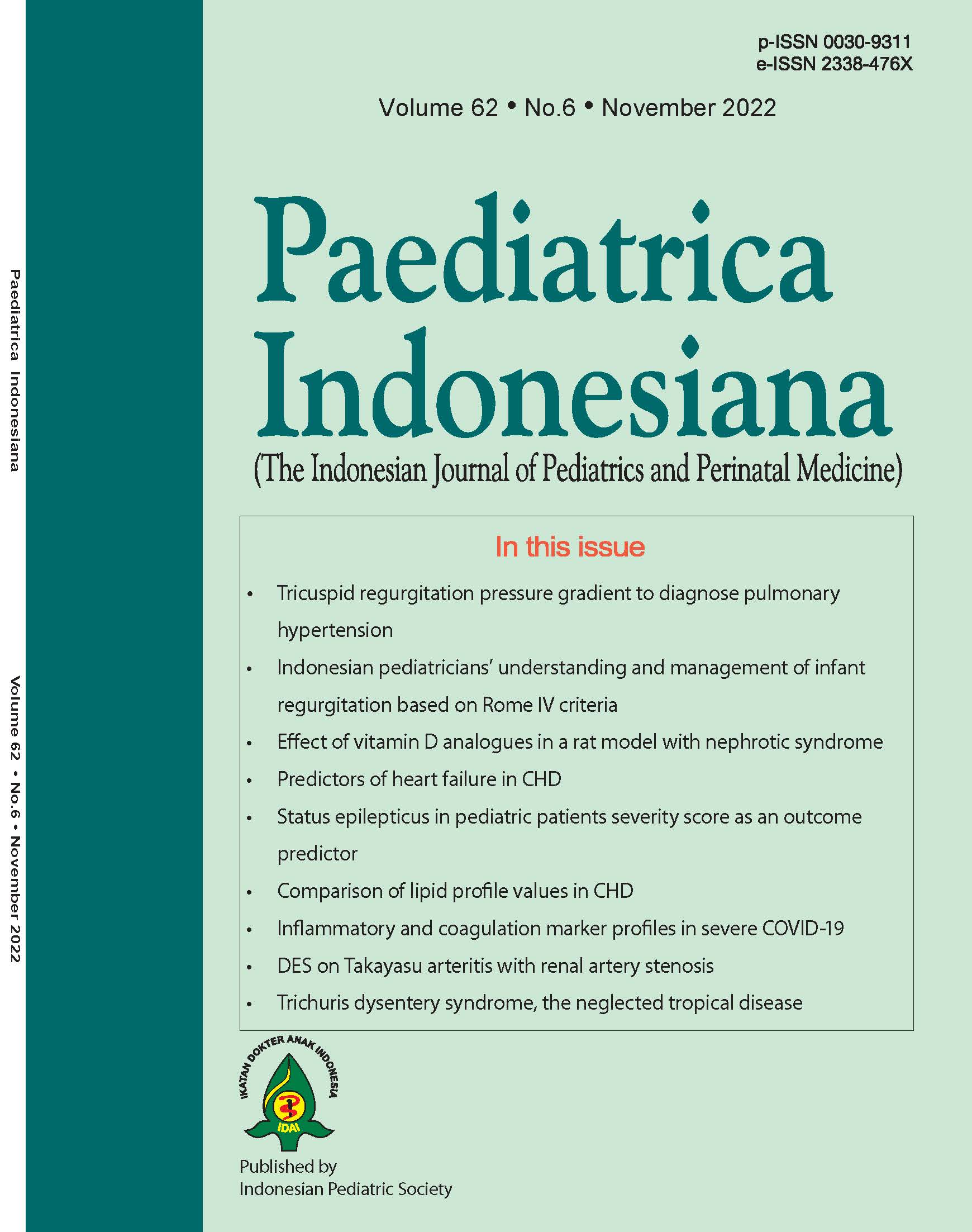Role of drug-eluting stent on Takayasu arteritis with renal artery stenosis
DOI:
https://doi.org/10.14238/pi62.6.2022.422-9Keywords:
Takayasu arteritis with renal artery stenosis; renovascular hypertension; drug-eluting stentAbstract
Takayasu arteritis (TA) is defined as granulomatous inflammation of large arteries involving the aorta and its primary branches. Takayasu arteritis with renal artery stenosis (TARAS) is a common cause of pediatric renovascular hypertension. The main purposes of TARAS management are to improve high blood pressure and recover renal function. When general medication fails to improve symptoms, renal revascularization may be attempted. Implantation of a drug-eluting stent (DES) has been used as an alternative strategy for pediatric renal revascularization. Here, we report on a 10-year-old, female, Javanese patient with bilateral TARAS who underwent DES implantation. Her clinical presentation was hypertensive crisis and worsened renal function. Bilateral renal artery DES implantation was performed successfully without complications. The child’s blood pressure was controlled using two anti-hypertensive medications after DES implantation and her renal function recovered. Dual anti-platelet therapy was given to minimize the risk of stent thrombosis.
References
2. Tullus K, Brennan E, Hamilton G, Lord R, McLaren CA, Marks SD, et al. Renovascular hypertension in children. Lancet. 2008;371:1453–63. DOI: https://doi.org/10.1016/S0140-6736(08)60626-1
3. Tullus K. Management of the renovascular disease in children with Takayasu arteritis. Pediatr Nephrol. 2015;30:1213–6. DOI: https://doi.org/10.1007/s00467-015-3093-7
4. Cheung CM, Hegarty J, Kalra PA. Dilemmas in the management of renal artery stenosis. Br Med Bull. 2005;73–74:35–55. DOI: https://doi.org/10.1093/bmb/ldh049
5. Ozen S, Pistorio A, Iusan SM, Bakkaloglu A, Herlin T, Brik R, et al. EULAR/PRINTO/PRES criteria for Henoch-Schonlein purpura, childhood polyarteritis nodosa, childhood Wegener granulomatosis and childhood Takayasu arteritis: Ankara 2008. Part II: Final classification criteria. Ann Rheum Dis. 2010;69:798–806. DOI: https://doi.org/10.1136/ard.2009.116657
6. Bicakcigil M, Aksu K, Kamali S, Ozbalkan Z, Ates A, Karadag O, et al. Takayasu’s arteritis in Turkey - clinical and angiographic features of 248 patients. Clin Exp Rheumatol. 2009;27:S59-64.
7. Brunner J, Feldman BM, Tyrrell PN, Kuemmerle-Deschner JB, Zimmerhackl LB, Gassner I, et al. Takayasu arteritis in children and adolescents. Rheumatology. 2010;49:1806–14. DOI: https://doi.org/10.1093/rheumatology/keq167
8. Rundback JH, Sacks D, Kent KC, Cooper C, Jones D, Murphy T, et al. Guidelines for the reporting of renal artery revascularization in clinical trials. J Vasc Interv Radiol. 2003;14:S477–92. DOI: https://doi.org/10.1097/01.rvi.0000094621.61428.d5
9. Zhu G, He F, Gu Y, Yu H, Chen B, Hu Z, et al. Angioplasty for pediatric renovascular hypertension: a 13-year experience. Diagn Interv Radiol. 2014;20:285–92. DOI: https://doi.org/10.5152/dir.2014.13208
10. Park HS, Do YS, Park KB, Kim DK, Choo SW, Shin SW, et al. Long term results of endovascular treatment in renal arterial stenosis from Takayasu arteritis: angioplasty versus stent placement. Eur J Radiol. 2013;82:1913–8. DOI: https://doi.org/ 10.1016/j.ejrad.2013.06.019
11. Shroff R, Roebuck DJ, Gordon I, Davies R, Stephens S, Marks S, et al. Angioplasty for Renovascular Hypertension in Children: 20-Year Experience. Pediatrics. 2006;118:268–75. DOI: https://doi.org/10.1542/peds.2005-2642
12. Niccoli G, Montone RA, Ferrante G, Crea F. The evolving role of inflammatory biomarkers in risk assessment after stent implantation. J Am Coll Cardiol. 2010;56:1783–93. • DOI: https://doi.org/10.1016/j.jacc.2010.06.045
13. Arce-Santiago M, Rodríguez-Cruz E. Treatment of a recurrent renal artery stenosis and stent fracture using a drug eluting stent in a pediatric patient. CEN Case Rep. 2016;5:18–22. DOI: https://doi.org/10.1007/s13730-015-0182-1
14. Agarwal G, Vats HS, Raval AN, Yevzlin AS, Chan MR, Gimelli G. Chronic total occlusion and successful drug-eluting stent placement in Takayasu arteritis-induced renal artery stenosis. Clin Med Res. 2013;11:233–6. DOI: https://doi.org/10.3121/cmr.2013.1132
15. Monagle P, Chan AKC, Goldenberg NA, Ichord RN, Journeycake JM, Nowak-Göttl U, et al. Antithrombotic therapy in neonates and children: Antithrombotic Therapy and Prevention of Thrombosis, 9th ed: American College of Chest Physicians Evidence-Based Clinical Practice Guidelines. Chest. 2012;141(2 Suppl):e737S-e801S. DOI: https://doi.org/10.1378/chest.11-2308
16. König K, Gellermann J, Querfeld U, Schneider MBE. Treatment of severe renal artery stenosis by percutaneous transluminal renal angioplasty and stent implantation: review of the pediatric experience: apropos of two cases. Pediatr Nephrol. 2006;21:663–71. DOI: https://doi.org/10.1007/s00467-006-0010-0
Downloads
Published
How to Cite
Issue
Section
License
Authors who publish with this journal agree to the following terms:
Authors retain copyright and grant the journal right of first publication with the work simultaneously licensed under a Creative Commons Attribution License that allows others to share the work with an acknowledgement of the work's authorship and initial publication in this journal.
Authors are able to enter into separate, additional contractual arrangements for the non-exclusive distribution of the journal's published version of the work (e.g., post it to an institutional repository or publish it in a book), with an acknowledgement of its initial publication in this journal.
Accepted 2022-12-05
Published 2022-12-05


















